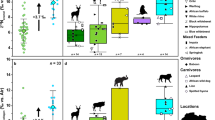Abstract
Stable carbon isotope analysis is now an established tool for investigating the diets of fossil taxa, but carbon isotopes provide us with limited information about an animal's ecology. Recent research suggests that mammalian oxygen isotope compositions might also prove profitable sources of ecological information. If we are to exploit this resource, however, we must improve our nascent understanding of oxygen isotope compositions within modern foodwebs. To this end, we have analyzed the oxygen and carbon isotope compositions of nine ecologically diverse, sympatric taxa from Morea Estate, Mpumalanga Province, South Africa. These data show that the Morea Estate faunivores are depleted in 18O compared to herbivores, and among the herbivores, frequent drinkers are relatively depleted in 18O. While more research is needed to address the mechanisms for and universality of these patterns, these results show oxygen isotope analysis to be a promising avenue of paleoecological research.
Similar content being viewed by others
Author information
Authors and Affiliations
Additional information
Electronic Publication
Rights and permissions
About this article
Cite this article
Sponheimer, M., Lee-Thorp, J. The oxygen isotope composition of mammalian enamel carbonate from Morea Estate, South Africa. Oecologia 126, 153–157 (2001). https://doi.org/10.1007/s004420000498
Received:
Accepted:
Published:
Issue Date:
DOI: https://doi.org/10.1007/s004420000498




